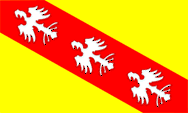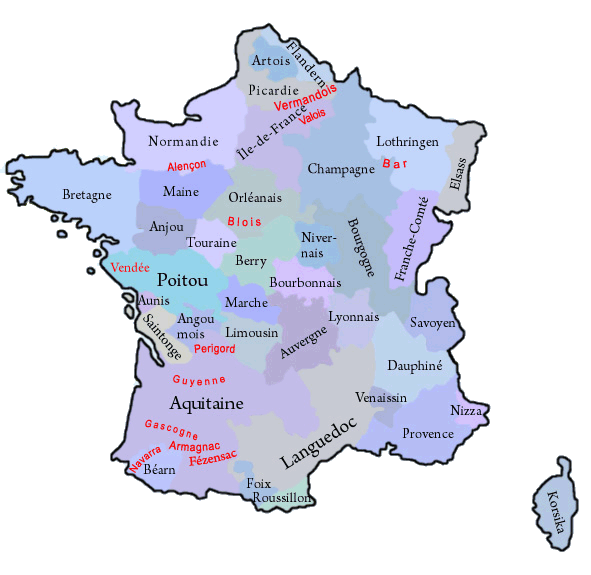mobile View, to the German Version tap the flag


- historical region in today's France
- former duchy
- own name, in German: Lothringen
- own name, in French: Lorraine
• Flag
• Meaning/Origin of the Flag
• Coat of Arms
• Meaning/Origin of the Coat of Arms
• Map of the historical Regions in France
• Explanations about the Regions
• History
• Origin of the Country's Name

Flag of Lothringen (Lorraine),
Source, by: Die Welt der Flaggen






The historic flag of Lorraine is a scutcheon-flag, its design is the image of the coat of arms of the Duchy of Lorraine. The between 1960 and 2016 existing Region of "Lorraine" used that model as unofficial flag.
Source:
Volker Preuß


Coat of arms of Lothringen (Lorraine),
Source, by:
Wikipedia (D)

The coat of arms of Lothringen (Lorraine) shows a golden shield, topped with a red slant right bar, which is in further topped with three silvery Alerions. Alerions are eagle with mutilated legs. The origin of this symbol is in the dark, but French heraldists say, that the Alerions were attached on shields as a sign of victory over foreign powers. However, the birds appeared first on the seal of the Dukes of Lothringen (Lorraine) in the 12th century, but they had there yet their catches (legs and claws). The mutilation appeared not until the 15th century.
Source:
Volker Preuß, Wikipedia (D)

The historical, French Regions:

in black: governorate and province in 1776,
in red: former county, province oder governorate
Map: Volker Preuß

The until the French Revolution existing provinces (or governorates) have been historically grown structures, which had their roots oftenly in former fiefdoms of the French crown, historic counties and duchies. They oftenly existed for hundreds of years and had preserved regionality (e.g. cultural particularities and regional languages). On the occasion of the French Revolution such phenomena were of course not desirable, and as part of their bloody and violent egalitarianism any regional references were eliminated. Shortly after the French Revolution the provinces were dissolved and France became divided into many départements, which should have approximately the same size and the same status. The départements were named after rivers or mountains, to use never and in no circumstances the name of an old province. However, there was no success in cutting the connections of the people of France to their respective regions, so that administrative regions were re-created in 1960, to have a better control in regional administrative processes. In this way became départements, which were placed in a historical province, administratively grouped to an oftenly historically named region. The resulted structures coincide only approximately with the boundaries of the old provinces. In the strictly centralist France any regionality is avoided, so that even the official flags of these regions mostly look like flags of companies, unloving, unhistorical, technocratic and modernistic, and these flags should not be a subject of any lexical considerations here. Only in a few of that regions, exist official flags which remember the historical models. But, even the existence of these today's regions is douptful, because in 2014 was passed a territorial reform valid from the year 2016, that reduces the number of the existing regions by merging to nearly the half. However, there exist unofficial flags in nearly all of these regions, which should remember the old provinces and the old heraldry.
Wikipedia Link to the regions of France:
click or tap here
FOTW Link to the regions of France:
click or tap here
Source: Flags of the World,
Wikipedia (D),
Volker Preuß

1st century B.C. · in today's Lorraine settle Germanic tribes (Leukers)
55 B.C. · Caesar, the Roman general and future dictator conqueres Gaul, as well as the today's Lorraine, which becomes annexed to the Provinces of Germania Superior and Belgica, later settlement by Alemanni
534 · the Franks conquer the territory of the Alemanni, with it the area of today's Lorraine, christianization
814 · death of Charles the Great (King of the Franks and Holy Roman Emperor)
843 · inheritance disputes, Treaty of Wirten (Verdun), the Frankish kingdom is divided among the three grandsons of Charles the Great, Lothar I. gets the central kingdom, consisting of "Lotharingen" (from Burgundy to Friesland), Burgundy and Italy
870 · Treaty of Meersen, "Lotharingen" comes to the realm of Ludwig II. (East Frankish Kingdom)
879/880 · treaties of Wirten (Verdun) and Ribemont, "Lotharingen" comes to the kingdom of Louis III. (East Frankish Kingdom)
911 · establish of the Duchy of Lorraine, under Duke Reginar
953 · Lorraine comes to the Archbishop of Cologne, dividing into two duchies, Upper Lorraine (on the lower reaches of the River Moselle) and Lower Lorraine (on the lower reaches of the River Meuse)
1055 · Henry I., King of France, claimes Lorraine for itself, however, deviates from a dispute
1106 · the Count of Leuven and Brussels acquire the Duchy of Lower Lorraine, and call themselves from 1183 Dukes of Brabant, the Duchy of Upper Lorraine remains as Duchy of Lorraine
1155 · the Duchy of Limburg, becomes dismissed as an independent duchy from the association of Lower Lorraine
1306 · Duke Dietbald II. (1304–1312) allowes female succession
1346 · Duke Rudolf (1328–1346) supports the King of France during the Hundred Years' War (French-English War) and falls at Crécy
1356 · Johann I., son of Duke Rudolph, continues the support of France and becomes captured in the Battle of Poitiers
1364 · Johann I., is captured in the Battle of Aurai, dies 1390 in Paris, succeeded by Duke Charles I.
1407 · Battle of Nancy, Charles I. (Connétable of France) beats the united Princes of Luxembourg, Bar, Juelich, Berg and Nassau
1431 · death of Charles I., the inheritance goes to his daughter Isabella, married to René (Renatus) of Anjou and Bar
1453 · René hands over the Duchy of Lorraine to his eldest son John II.
1473 · Nicholas, son of John II. dies, extinguish of the female line of the Dukes of Lorraine, the succession goes by René II. to the male line, René II. is the grandson of a nephew of Duke Charles I.
1475 · Charles the Bold of Burgundy expels René II.
1477 · Battle of Nancy, Renatus II. regains his dukedom
1545 · Franz I. (grandson of René II.) dies, the Duchy goes to the minor son Charles II., the regency takes his mother Christine, Princess of Denmark
1552 · King Henry II. of France seizes the Bishoprics of Metz, Toul and Verdun, and occupies the Duchy of Lorraine
1559 · the French withdraw from Lorraine
1618–1648 · Thirty Years' War, King Louis XIII. of France occupies Lorraine in 1632
1659 · Pyrenean Peace, Cardinal Mazarin cedes Lorraine to the German Empire
1670 · King Louis XIV. of France occupies Lorraine
1675 · Death of Duke Charles III., succeeded by his son Charles IV.
1690 · Death of Duke Charles IV., succeeded by his son Leopold Joseph Charles
1697 · King Louis XIV. of France awards back to Duke Leopold Joseph Charles his own duchy
1729 · Death of Duke Leopold Joseph Charles, succeeded by his son Francis Stephen
1733 · Polish War of Succession, French troops occupy Lorraine
1738 · Peace of Vienna, Lorraine gets transferred to France, the country retains its seat and vote in the Reichstag and the Kreistag, Duke Franz Stephan receives as compensation the Grand Duchy of Tuscany
1766 · France annexes Lorraine, but it is equipped with some special rights of a estates state, what could be an own estates assembly (a kind of parliament) or may even mean an own tax jurisdiction towards the king
1776 · the already in the 14th century created governorates of the civil administration of the kingdom of France become committed to a number of 39, and correspond in this way to the number of provinces, in previous years could any provinces be summarized in one governorate
1789 · French Revolution, the governorates (provinces) become abolished, Lorraine is divided into departments (essentially Meuse, Vosges, Meurthe, Moselle)
1792–1805 · French revolutionary armies attack the German Empire, France occupies in 1797 all the German territories west of the Rhine
1801 · Peace of Luneville, the Holy Roman Empire of German Nations cedes officially all areas of the left bank of the River Rhine to Napoléon's French Empire
1814–1815 · Vienna Congress, reorganization of Europe after the Napoléonic era, Lorraine remains in France
1870–1871 · German-French War, battles of Gravelotte and Spichern, German victory in five months, on 18th of January in 1871 will be proclaimed the German Empire at Versailles, peace treaty on 26th of February in 1871, France has to cede to the German Empire Alsace and parts of Lorraine (Meurthe Departement, Arrondissements of Saarburg and Chateau-Salins), establish of the Imperial Province of 'Alsace-Lorraine'
1871–1873 · direct government by the Federal Council of the German Empire
1874 · first elections to the German parliament, formation of a National Committee for Alsace-Lorraine
1879 · installation of a governor as head of Alsace-Lorraine
1911 · the country gets its own constitution and gets equality among the other German states, first and last election for the parliament (Landtag) of Alsace-Lorraine
1914–1918 · First World War, the western front passes through Upper Alsace
11th of November 1918 · Armistice of Compiègne, Alsace-Lorraine is to vacate by German troops within 15 days, with the withdrawal of the German troops, the Republic of Alsace-Lorraine was proclaimed, but startet to transform into a Soviet Republic, French troops were called in to help, who finished the Soviet Republic
17th–21st of November 1918 · French troops marching in, in Muehlhausen (Mulhouse), Colmar, Metz and Strassburg (Strasbourg)
17th of October in 1919 · dissolution of Alsace-Lorraine by France, 200.000 after 1870 immigrated Germans have to leave the country, after an appeal of the USA it was allowed to return for the half
1919–1940 · French assimilation policy towards the German population causes growing discontent and dissatisfaction
1939–1945 · Second World War, on 19th of June in 1940 the German Wehrmacht occupies Alsace-Lorraine, the country becomes integrated into the German administration and into the NSDAP-districts, but becomes not officially re-annexed to the German Empire, it comes to expulsions of some French out of the country, in 1942 introduce of conscription, conscriptions into the German Wehrmacht and the Waffen-SS, January 1945: Allied troops reach Alsace-Lorraine, re-establishment of the French administration, once more onset of the French policy of assimilation
1960 · reintroduction of regions in France, formation of the Region of Lorraine, but not within the historic boundaries, just by integrating of the departments of Meuse, Vosges, Meurthe, Moselle
2016 · the Lorraine region (Lothringen) merges with the Champagne-Ardenne and Alsace (Elsass) regions in the new, larger region of Greater East (Grand Est)
Source:
RetroBib Retrobibliothek,
Atlas zur Geschichte,
Wikipedia (D)

The name Lorraine (Lothringen) goes back to a grandson of Charlemagne (Charles the Great), Lothar I., who gets the central realm (from of Friesland to Italy) at the division of the Frankish Empire in 843 AD. The northernmost part of this kingdom was called "Lotharingen", probably the domain of Lothar. In the year 911 it has developed into the Duchy of Lorraine under Duke Reginar, which was divided, however, in 953 in Upper and Lower Lorraine. in the year 1106 the Duchy of Lower Lorraine was renamed in Duchy of Brabant, Upper Lorraine continued as Duchy of Lorraine to 1801. Parts of Lorraine became in 1871 part of the German Imperial Province of Alsace-Lorraine, which in 1918 – after the First World War – has to be ceded to France. In German the country is called "Lothringen".
Source:
RetroBib Retrobibliothek


![]()






